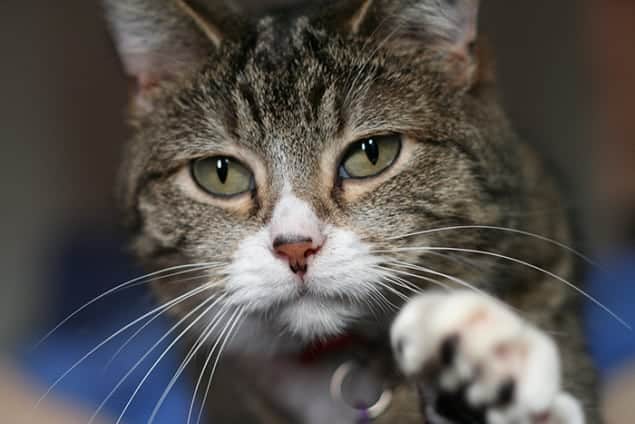
A link between pupil shape and the feeding behaviour of animals has been made by studying the eyes of 214 species. By modelling how differently shaped pupils collect light, researchers in the UK and US have argued that the shape of an animal’s pupil – the aperture through which light enters the eye – is related to whether that animal is predator or prey.
The study reveals that herbivorous prey animals such as deer and zebras are likely to have horizontal pupils, while predators actively hunting during the day – like cheetahs and coyotes – usually have circular pupils. Furthermore, animals that hunt at night, or both day and night, tend to have vertical pupils. This vertical group includes some foxes, cats and snakes.
Scanning the horizon
To understand how certain pupil shapes can benefit different types of animals, physicist Gordon Love and colleagues at the University Durham in the UK, along with psychologist Martin Banks and colleagues at the University of California, Berkeley, created computer models of the optical properties of different pupil shapes.
Their models suggest that horizontally elongated pupils in eyes located on the sides of the head give herbivorous prey animals a panoramic view of their surroundings. This helps these animals to spot a predator approaching on the ground from any direction, and also gives the animal a good sense of which escape routes are available if they are attacked. The horizontally elongated pupils also allow light to enter only in the directions that are most necessary for creating a panorama, thus avoiding dazzle from the sky above where there are no threats to these animals.
“Elongation in the horizontal direction effectively optimizes the amount of light entering [the eye] and makes a better image of the ground, which is horizontal. If a prey has to run away, it has to be able to see the ground in focus,” says Love.
Rotating pupils
The team also observed that some grazing animals rotate their eyes when they dip their heads while feeding. This is seen in sheep, goats, horses, moose and white-tailed deer, and the researchers believe that the rotation occurs so that the pupils remain horizontal and the animal is able to maintain its panoramic view of its surroundings.
When Love and colleagues studied vertically elongated pupils, they found that such pupils offer an advantage to ambush predators – creatures that hunt by stealth and often remain still for long periods of time. The team found that vertical pupils allow an ambush predator with forward-facing eyes to make a very accurate measurement of the distance to its prey without moving its head or changing its vantage point – strategies that are used by some other types of predators. “Ambush predators can’t [move], because if they did, they’d give their presence away,” says Love.
“Countless counter-examples”
However, Ronald Kröger, a biologist at Lund University in Sweden who studies the optical properties of animal eyes and who was not involved in the study, is not convinced given the enormous diversity of animal eyes. “There are countless counter-examples,” Kröger says. “A tiger is much larger than a house cat…and may have to judge longer distances more accurately than a cat. It beats me why a tiger gets away with round pupils.”
Love says that this discrepancy may have to do with the height of an animal. “When animals look along the ground, the depth of field [or range of focus of the eye] depends on how tall they are. Taller animals experience less of a blur for the same field of view,” he says. Shorter animals, like domestic and wild cats, have vertical pupils to reduce that blur, but big cats – like lions and tigers – are much taller and don’t need vertical pupils, he adds.
The research is described in Science Advances.
In the video below, Love explains why horizontally elongated pupils that can rotate are beneficial to grazing animals.



